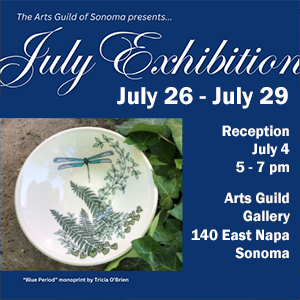 Teri Shore is a long-time environmentalist and journalist who has lived in Sonoma Valley for more than three decades. She is an avid hiker, backpacker, and wilderness advocate. As an environmental campaigner, she championed winning campaigns to preserve greenbelts and open space, create safe havens for endangered species, and clean up marine pollution for nonprofit advocacy groups.
Teri Shore is a long-time environmentalist and journalist who has lived in Sonoma Valley for more than three decades. She is an avid hiker, backpacker, and wilderness advocate. As an environmental campaigner, she championed winning campaigns to preserve greenbelts and open space, create safe havens for endangered species, and clean up marine pollution for nonprofit advocacy groups.
Wild over wildflowers
Wildflowers enthrall me. Over the past three years, since I lost Stan and stopped working, I’ve become enchanted by the native wildflowers that brighten our hillsides once everything’s turned green. And now I’m learning when and where to find them!
For a long time I could never remember the names of the wildflowers season to season. Those flower fanciers who could name them left, right and center always impressed me. How do they do it? Now I’m becoming one of them!
I’m excited when the Milk Maids appear as they are the first wildflowers we usually see after it rains in Sonoma Valley. The small white flowers with four petals that grow on a tall stem populate our valley and hills from January until as late as May. When they blossom after winter’s wet and chill, we wildflower enthusiasts tell each other, “The Milk Maids are out!” with a knowing glance.
As the season gets underway, we might spy interesting fungi and luscious moss, but nothing excites us early in the spring more than a tiny purpley Fairy Slipper aka Calypso orchid under the redwoods. Or the maligned Fetid Adder’s Tongue, an intricate member of the lily family that blends into the forest floor. The flower is dark maroon to brown and streaked. It has three flat, spreading, pointed oval or lance-shaped sepals and three narrower, linear or fingerlike petals. The sepals are pale or greenish and striped or streaked with dark purple. The flower got its name because of its “disagreeable scent,” according to Calscape.org. Let’s rename it! How about Redwood Lily?
Before long, dark lavender Pacific Hound’s tongue starts sprouting toward the sky. Bushy Warrior’s Plume adds maroon dusters to the trail. Delicate magenta Shooting Stars join the colorscape, pointing to the grass and earth. Next comes Douglas Iris in many hues, and all the yellows: Meadowfoam, Tidy Tips, Sun Cups. Of course every February, it’s mustard – not native and mostly planted, but gorgeous nevertheless.
This year, I found many Red Larkspur along Nun’s Canyon Road, a bunch of Yellow Monkey Flowers along Adobe Canyon Road, and Buttercups and Blue-eyed Grass everywhere! But not so many big yellow Mule’s ears or Shooting Stars. Not really a super bloom this year, but still lots to see.
One day I went in search of the Dutchman’s Pipe, an interesting and evasive native vine. It is not uncommon, but I’ve rarely seen it. The fascinating flower stopped me in my tracks when I spotted it about three years ago. Low to the ground, its white and red pouch of a flower attracts the Pipevine Swallowtail Butterfly to lay its eggs—the only plant used to reproduce. I’ve only seen the Dutchman’s Pipe growing here at the top of the trail at SDC that rises from Fern Lake to Camp Via. Done flowering by now.
Now I also know where to look for another early season favorite – Mission Bells aka Checker Lily – bell-like on tall stems with multiple hanging flowers colored in earth tones from brown to green to maroon, and usually speckled. They grow on the trail down to the Wolf House at Jack London State Park. Recently I saw dozens of Mission Bells along the switchbacks on the North Slope Sonoma Mountain Trail at the regional park off Sonoma Mountain Road.
While there, we also spotted a large bunch of big white Trilliums, aka Giant Wake Robins, on the same trail on our way back down. Somehow, we didn’t spot these luscious plants on the way up!
Learning the wildflowers happened for me slowly and almost imperceptibly. The more I go out looking, the easier it is to remember the wildflowers. Having more time, I can spend it exploring and discovering wildflowers. My mind is less cluttered with work and obligations. The wildflowers also gave me bits of joy when I was sad and grieving. They still do.
What really helped me learn the species was posting on iNaturalist. There you get a choice and need to decide what wildflower you’ve seen. As of this moment, I’ve posted 771 observations of 431 species—mostly wildflowers (under tkestrel). Consulting guides and free local wildflower guides also help. Going on wildflower tours with local experts is a big plus.
I’ve learned that many of our favorite wildflowers have multiple sub-species. The most recent one for me to figure out was the delicate Woodland Star: Hillside or San Francisco Woodland Star? They look alike to me, but the shape of the ovum is different—square in the first, and pointy in the second.
Some plants like vetches and peas are just too hard for me to decipher. Plus I don’t really like them as they tend to tangle and overtake everything, whether native or invasive.
Now I’m waiting for my summer favorites to start blooming, specifically Mariposa Lilies and penstemon, both of which have many species that I love to search for and identify here and there.
What a Wild Valley!






